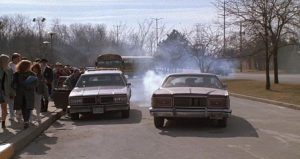Cars used to burn oil – obviously. They still burn oil today – but sometimes not as obviously. Often, there is no blue cloud trailing the car with the loose engine. It still runs pretty good, too. So the owner assumes it’s in good shape.
And doesn’t check the oil.
Soon enough, it won’t be running so good – as an engine with half the oil it should have in the pan (and in circulation) will get tighter as the heat and friction increase – in tandem with the oil level decreasing – until the moment comes when it locks up or some similar lubrication-lacking catastrophe occurs.
And then it burns no oil at all.
This almost and could-have happened to a friend of mine who asked me to change the oil in her car, which I did. Last spring. A few weeks ago, she called to tell me her car seemed to be not-running as well as it had been and besides, it needed another oil change – so I had her bring it over. The engine had a little rattle when she revved it so I told her to stop revving it and shut it off. After a few minutes – to let the oil settle back into the pan – I checked the level via the dipstick, which is probably the first thing to do when an engine begins to make rattling or other such disconcerting sounds of friction.
There was nothing on the dipstick except varnish where the oil had been. When this happens, you’re not just low; you’re running close to empty.
And so it turned out.
I got the car up and got under. Removed the drain plug bolt – and out came about two quarts of very black, very thick oil – not the five that should have come out.
But there was no sign of seepage. No oozy oil pan gasket or indication of dripping. Which indicated burning.
The engine had fairly high miles and was probably a little loose around the valve stems or piston rings and thus oil was slipping past and getting burned along with the gas. In the past, you’d get a visual clue this was happening when you looked in the rearview – and saw the blue contrail. But modern cars burn without smoking as much – or at least, as obviously.
It is probably because modern car exhaust systems have two and sometimes as many as four catalytic converters and these chemical exhaust scrubbers generate tremendous heat to keep the car’s exhaust clean. That heat-treatment probably also serves to hide oil burning – especially in the early stages.
Which is why the danger of running low on oil without knowing it has increased – and with it, the danger of major engine damage if it’s not detected in time.
All engines burn oil, incidentally. And some naturally burn more than others. This is a thing not advertised in the owner’s manual but which the owner ought to familiarize himself with – by establishing how much oil consumption is normal for his car. Which will also establish a baseline for abnormal oil usage.
This is easily done by checking the oil level regularly after an oil and filter change. Once a month is ok for a new/newer car with low miles; once every two weeks for an older car with high miles – and once a week for a car with leaks.
Then top it off as often as necessary.
This won’t prevent the engine from burning oil. But it will prevent the engine from burning up from a lack of enough oil.
Also: don’t assume that because the “oil” light hasn’t come on there is plenty of oil in the engine. The light in my friend’s car didn’t come – and probably wouldn’t have until the engine ran out of oil altogether.
At which point, a light that says “game over” would be more informational than the one that says “oil.”
. . .
Got a question about cars, Libertarian politics – or anything else? Click on the “ask Eric” link and send ’em in!
If you like what you’ve found here please consider supporting EPautos.
We depend on you to keep the wheels turning!
Our donate button is here.
If you prefer not to use PayPal, our mailing address is:
EPautos
721 Hummingbird Lane SE
Copper Hill, VA 24079
PS: Get an EPautos magnet or sticker or coaster in return for a $20 or more one-time donation or a $10 or more monthly recurring donation. (Please be sure to tell us you want a magnet or sticker or coaster – and also, provide an address, so we know where to mail the thing!)
My eBook about car buying (new and used) is also available for your favorite price – free! Click here. If that fails, email me at EPeters952@yahoo.com and I will send you a copy directly!












Back in the day, vehicles had a gauge that would show you if the pressure is dipping, and you could add oil long before it became a problem.
Now they just have idiot lights that say “there she blows”.
When I was a kid, I just naturally had to do everything myself. I didn’t have the time or money to sit around waiting for someone else to change my oil. Now there’s a shop just down the street that can change the oil for less than I can, and in less time.
Years ago, I bought a brand new Hyundai Elantra, and took it in to have regular maintenance done to prevent the warranty from becoming void. When the ten year warranty ran out, I lapsed on changing the oil. One day it dawned on me that I hadn’t changed the oil in over a year or so. I checked it and the stick was dry. I poured four quarts in before it made it back up to the full line. I don’t know how those cars can run without any oil, but that one did for quite a while. I put 250k miles on it, and it never gave me any problems. Those things are practically indestructible.
Hi Scharkle –
My buddy runs a repair shop; he got a beater in one day that the owner ended up just leaving with him as it was not worth fixing. My buddy drained the oil and dropped the pan and we ran the engine without any pressure lube … and it ran for about five minutes before it began to spit crank bearing shavings… and then locked up!
I had a 2005 Ford E250 van (used mainly for work purposes, mostly highway driving) that still had the original 5.4L engine with 722,000 miles when I finally sold it. It had no major engine repairs. It was burning about a quart every 2-3,000 miles using mostly Mobil 1 synthetic. Once in a great while, it would require almost 2 quarts to get it topped off. I would sometimes use different brands of synthetic oil, or even mix them and on rare occasion added a non synthetic to top it off. Sometimes when I had the oil changed, they would put in almost 7 quarts when the manufacturer called for 6 quarts. I would change the oil every 7-8,000 miles or even as long as 15,000 miles if I was using the Mobil 1 extended version. I always wondered about the oil filters and if they could go for such long periods. I saw no smoke coming from the exhaust and even fried the cats once due to some problems with the over the plug distributors, I think it was. The truck was still running ok when I got rid of it. It took some abuse and still kept on ticking.
Now I am driving a turbo charged 4 banger and have no clue how long it might last. Won’t matter since the global warming crowd wants to eliminate all gas engines by 2030.
Haw! Remember when all the panic was over Global Cooling, at least until the hysterics skulking around us discovered that average Earth temps were actually rising slightly, thus giving rise to the Global Warming hysteria. Our Third Rock from the Sun has been warming and then cooling since living species inhabited the planet and will continue to do so until our Sun goes Supernova and exterminates all life on Planet Earth. Oh, woe and despair, just another Doomsday scenario to worry about – how much more can we take?!
The climate has been changing long before man existed. We’re in the part of the orbit right now where the sun is closer and warms the planet more. Don’t worry, it will reverse although it might not be in your lifetime.
But it’s had rising sea levels virtually forever. How did those Asians people now call Indians or indiginous get here? They walked. Many millennia later the sea level rose to make it a swimmy type thing and now it’s a deepwater ship type thing.
I’ll probably cry myself to sleep tonight worrying about Miami losing a foot of beach and some day, being underwater. Maybe they’ll rename it Venice.
Eric, let me add to what you said, oil is my business. About vehicle engines oil. When one looks at engine oil under a powerful microscope normal engine oil that is known as hydrocarbon oil looks like billions of round balls. Synthetic is more like links. When the engine is running and more so under load, on the bottom of the power stroke those balls and or links cushion the blow the rod puts onto the rod bearings. As we know when the bearings start wearing the oil pressure drops to the top end and more oil gets burned as the top end wears more due to the lack of oil. It’s hugely important to change the engine oil to keep the integrity and resiliency of the oil to cushion the power stroke blow at the bottom of the stroke because the life of the engine is in the bearings on the crankshaft. Yes, oil does more than just that but keeping a positive schedule of regular oil changes is very important. Not staying on top of ones oil changes is simply being lazy minded, not indifferent or ignorant, it’s being lazy because everyone knows vehicle need engine oil changes. So when the oil change business puts the little sticker with the mileage on the windshield for the next oil change, dummy up and get it taking care of and if needed stop by and see them to check your oil in between oil changes. Eric, stop chasing girls that don’t see their oil is changed regularly, you deserve better.
While this article seems to be about low engine oil, it is really about the fiction of the “Strong and independent woman”. The low oil is in her head, not in her automobile. It is great to check her oil level, but what is her role in making your life better ?
Damn little, I’d bet…
As a group, women were and are disproportionally responsible for the existence of Sleepy Joe and his Upstairs Maid. They intend to swap checking your oil for checking your electrolyte charge.
Whiskey Tango Foxtrot ?
Do we really want to empower that element and their vision for what is left of the US ??
Do you hand ammunition to your enemy ?
MGTOW !
Hi Jack,
To be fair, lots of men are like the women you describe. A friend of mine has a boy who is growing up to be a girl. The kid cries when his video game doesn’t work. He is a young teen and soon will be a young man with no idea how to check much less change engine oil. It is not his fault. I am going to try to help him out by showing him how to do things like check oil – and why. Maybe it will help. But this is a systemic problem and while it is true feminism caused much of it, so did men – by allowing it.
Agreed but there comes a time when one needs to walk on their own two feet. Look at all the quick car lube joints up and down the highway. How many pieces of junk mail and or coupons from quick oil change joints come in the mail, often. Critical thinking skills come with the package in normal people that are not special needs. Mistakes are part of the learning process, lose the motor for the lack of staying on top of the oil, tough medicine but one will learn and know better. I know of people that one motor wasn’t enough of the learning process, I can only hope by the 3rd or 4th engine the light comes on, or rather stays off.
One more thing about aging vehicles is consider thicker oil. My trailblazer was showing low oil pressure with 5w30, so I put in 1/2 qt of synthetic GL4 and now its running properly quiet, good oil pressure and more power. I now use 6qts of synth motor oil and 1qt of synth gear oil. Its over 250,000 miles already.
I’ve been trying to discover if there was a pattern in what engines burn oil. I haven’t owned many cars. Two V6s and one I4. Only the I4 burned/consumed oil, so I initially figured it must have something to do with the strain or pressure per cylinder, and the less work allocated to each cylinder, the less likely oil consumption/burning is. But the comments on this page show even V8s use oil, and my family members have I4s, and they don’t burn oil. They are DOHC I4s, like my DOHC V6s, and my I4 was SOHC. The V8s mentioned here were OHV. So does it have more to do with having four valves per cylinder as opposed to the number of cylinders? The subaru H6 mentioned is DOHC 24 valve, but we’ll blame the oil burning on its engine orientation. Then we have a comment saying a DOHC 16 valve 2.3 burned oil but the larger displacement 2.5 did not. And yet still, I’ve seen comments elsewhere on the internet saying their DOHC V6s burned oil, so even with my known goods I don’t think I’ll be able to truly find a pattern. Nothing that will assure me when buying something that it won’t burn oil.
If checking oil at the gas station do it last,if you check it immediately after pulling in it will check low.This was one of the old tricks to sell more oil back when full serve existed.
Had a 2.2L Subaru Legacy wagon for 4 teenage girl drivers: each one had a story: “Dad, the genie light is on!” – Cam seals were gone, puking oil. “Dad, the engine clacks” – added 4 qts to a 4.2qt capacity crankcase. “Dad, I went into a ditch but got out, can I drive to work” – no sweetie, you just punctured the oil pan. Three different kids over a span of about 10 years. That Subaru was one tough little car!
Best oil story i got was from back in college long before evs. I asked a lady if she wanted me to check her oil while i was working at a gas station and her response was a kicker- “this is a Mercedes, it doesn’t take oil.” I said good luck with that and walked away. But thanks Eric, now you’ve got me going out and checking the oil level in the cars.
It used to be before synthetic engine oil, you would change the oil every 12-1500 miles, you had to, oil breaks down with use and wears out, a no-brainer there. You have to check your oil. Change your oil. After five years, you’ll need a new battery.
Use Mobil 1 and the engine maybe uses 4 ounces of oil every 7500 miles. Knock on wood, a good engine, 4.0 L V-6 Nissan motor in a Pathfinder.
Of course you have to read on about Amsoil, the cost of a new filter and six quarts of 5w/30 oil is one hundred dollars. Always have heard about it, never really knew much about it, I’ll try it on a different vehicle.
Had a five gallon bucket half full of carb cleaner with a dip tray to drop the parts into the cleaner. Oh what fun it was. Add to your plethora of lubricants, have a quart of Marvel Mystery oil and you’re complete.
One thing to keep in mind also, is that today’s low displacement, high boost and high compression engines use low tension piston rings for added fuel economy. These engines burn oil like crazy and people don’t expect it.
Engine oil usage, on a new vehicle, is a clear sign of the quality of the engine build/design. Just about all my GM vehicles “used oil”. My Toyotas, with the 3.5 liter V6, show no discernable oil consumption between 5k oil changes.
Don’t forget that over a period of time, some gasoline “blends” (blow by, oil seepage past the valve guides and piston rings) with the oil and can make it appear that oil consumption is nil.
This is why diesels generally are more long-lived than gasoline engines. With a diesel, the fuel is a lubricant, unlike gasoline, which is a solvent.
Then there’s BMW informing that 500mi per quart is “normal”. BMW solved the problem – eliminated the dipstick.
My 1990 Chevy C1500, with the 350, will launch a cloud of white smoke upon starting cold. I’m told something about the oil in the head running down into the valves or some damn thing. And yes, it does burn oil, and not only that, since the ‘Rona, and the lack of driving that followed, it seems to accumulate a bit of water, too. Since learning this, I try and drive it long enough to boil away the water. We’ll see with the next oil sample.
Any idea of the normalcy of the white smoke from anyone? Yes, it appears white, but there has been no sodium or potassium ingress to indicate a coolant leak.
White? That is not oil. Oil burns blue-ish.
Sounds like a coolant leak. Is your antifreeze a browner shade of green? Any froth on the oil dipstick?
Anon,
I just started it to observe the smoke. It does have a bluish tint and smells of oil. Perceptions can be… Idiosyncratic.
The coolant appears red, and maybe I’ll take a sample of that, too, to see what I find.
But, as I said, there was no sodium or potassium to indicate coolant ingress. Oil and coolant sampling (partially) what I do for a living, BTW. I’ll test it for glycol as well, next time. The oil looks pretty clean right now, but it has probably <1,000 miles on it.
I’ll test it for glycol as well, next time. The oil looks pretty clean right now, but it has probably <1,000 miles on it.
Many Japanese makes use red colored antifreeze; the first time I checked my daughter’s Mazda I noticed that, then checked the owner’s manual just to be sure.
Mike,
It is ELC (extended life) coolant, but color doesn’t mean so much these days, if it ever did. Some have just a straight colorant or dye. Others have a pH indicator, so that it changes color as the pH drops. But to truly know what you have in your system, some chemical analyses must be done.
ELCs will generally be based on organic acids, (when new) have less nitrite than conventional coolants, and have no silicate, but instead have molybdate and borate as corrosion inhibitors.
Conventional (old school) coolants work at a higher pH, and rely on silicates to coat the inside of the system, protecting it from corrosion. Drop the pH too low, and the silicate crashes out of solution, and corrosion begins.
Coolant chemistry is its own little planet. It gets even more involved than what I stated here, but in a nutshell…
Hi BaDnOn,
Thanks for the info, interesting stuff, way more complex than I realized. Used to change out antifreeze/coolant every other year back in the day (‘70 – 90’s cars) now only do it every 5 years or so (‘03 Corolla), hope that’s good enough.
Mike,
Well, I think so. They quote ELC as lasting 100-150k miles. Conventional is about half that.
Our 1999 Ram custom van 5.9 has low miles, runs beautiful with no leaks or signs of smoke but takes a quart of oil every 1500 miles to keep full. Our 2001 GMC truck 6.2 (even lower miles) does the same. Seems excessive to me but both have always been this way. Plan on keeping them until they take ME to the bone yard.
Bear, try this. Get some Amsoil engine/transmission flush and add it and run it 20 minutes at most at 1500 to 2000 rpm. Drain that gunk out then put a quality(Wix are really good for easily had filters). Fill it with Mobil 1, not because it’s so great but it’s synthetic and will clean hell out of that engine. It will look like oil out of a diesel when you drain it again it’s down a quart. Do that again and see if it doesn’t go further. Then change over to Amsoil oil and filter, the proper weight. It will go further. I’ve had this happen on a few vehicles I did this to that used oil. Once again that Amsoil will be black as black but hopefully with more miles.
If it runs more miles without using a quart, stay with Amsoil. I bought my 2000 Z 71 with exactly 200,000 miles and the lifters were raising hell. I wasn’t familiar with LS engines or I’d have passed. I didn’t know it wasn’t like a regular small block and required moving the heads and replacing the lifters with some really expensive lifters.
So I did the old flush at 3500 miles when the Amsoil high mileage oil that had just been installed was a quart low. I dutifully put ona Wix filter and filled it with Mobil 1 because it’s cheap. I got another 4500 miles before it was a quart low and then changed to Amsoil and Amsoil filter. I got over 5500 miles on that change before being a quart low. Same thing once more and it was 6500 before needing another quart(still black as diesel oil). The next change added another 1,000 miles and it was low but not a quart low but nasty nasty nasty and it had less knock every change. I got it up to 9,000 and changed it because of nasty and some oil used. I’ve continued to do this and ran it to over 12,000 miles on one change but not low, just filthy. I finally got it clean enough that now 6000 miles it still looks decent. I don’t like to run one, especially with 248,000 miles on it. The last change cleaned it to the point the valve cover gaskets started leading.
Once this godawful cold is over I’m going to replace the gaskets and see what things look like. Another thing you’ll notice from Amsoil is when you work one hard and keep the temp up there, the pressure doesn’t drop. Car Wizard on YT has out a new video and he speaks so highly of LS engines he doesn’t run a Chevy just because of other problems. He said he could rebuilt an LS with his eyes closed they were so simple and they really are. Someone asked him if he’d buy a pickup with an LS motor under any circumstance. He said if it had 370,000 miles he wouldn’t because of obvious reasons.
Another automotive channel rebuilt an LS out of a wreck vehicle with well over 200,000 miles. It was obvious they’d used conventional oil and had let it go a little long due to the small amount of crud in the pan. It still had crosshatch on the cylinders and no wear on the piston skirts. They only rebuilt it as a lesson since they had no idea how it had been treated before the wreck. They were impressed by the lack of wear. The oil pumps can be rebuilt and made better doing some grinding to smooth the flow and add a couple washers to increase the pressure.
BTW, the old 2000 still runs like a scalded dog. I did the same thing with my 6.5 diesel and it got to the point where it barely used oil. That’s a simple engine to build and make it nearly indestructible by using good head bolts as opposed to the crap GM used. It doesn’t make the power of a 7.3 but it won’t take a crap on you either. Mine got 18.5 mpg at 70 mph and 4.10 gears.
If an engine is built correctly they will break the norm. When I rebuilt my 6-71 Detroit It had a few thousand on the oil and my uncle who was a tractor mechanic couldn’t believe the clean oil at that mileage. I used Delo 400 and wouldn’t use Shell for any reason. I’ve emptied hundreds of Shell Rotella and Rotella T because that’s what the owner wanted. Every time there’s be a bunch of crud in the corner of the bottle. Shell can keep that crap.
By the way, why can’t a woman check the oil? My wife could check oil before we even met and she had to be able to change a flat before her mother would let her drive, license or no. She was a good woman. She knew a woman who couldn’t changes tires could be the victim of her incompetence. The only thing the wife has done is have a transmission screwing up and I’d ask her if she’d checked the oil level. So one day when she said it was full I said “Show me”. We went out there to that 67 Impala and she pulled the dipstick out and showed me it was full. I got out the owners manual, turned to “Checking transmission oil” chapter and had her read it. She was unaware it had to be hot and in Park. We drove it down the road and warmed it up good, then pulled over and put it in Park and it was down considerably. It was time to change oil and filter anyway.
If there’s anything going on she doesn’t understand she lets me know right away. It’s saved us many vehicles. Her one failure is driving one forever without washing it which drives me crazy.
My 2012 Subaru Outback has two warning lights for oil.
One is yellow and is for “oil level” which basically means “you’d better check your oil and top it off if it’s low pretty soon.”
One is red and is for “oil pressure” which basically means, “stop and check your oil right now, and I mean, right now.”
Parking on a really steep hill for a long time can cause a false alarm with the yellow light. I check my oil nevertheless when it happens because it’s more likely to happen when your oil level is low.
Speaking of which, given that the Subaru boxer 6 consumes more oil by design, one has to be diligent about the oil level. Supposedly newer Subaru engines have that problem less than older ones.
Ecch. Seeing the carbon caked on the inside of that engine block reminds me of the F100 I bought 30 years ago with a blown motor for $300. The seller said “that truck was my baby” but apparently he never changed to oil, because when I opened up the rocker covers to diagnose the problem everything was caked with carbon. I had never seen an engine so bad.
I bought a used engine and transmission for $275 and in after a couple of nights work had me a pretty decent truck. Drove it for 3-4 years until the reverse band went on it and sold if for $500.
Things seemed so much easier back then…
As a Mazda fan I learned the hard way about oil consumption. Bought my son a 2005 Mazda 3 with the 2.3. He drove it for a couple of months and one day the ‘oil’ light came on and a check showed no oil on the stick. Turns out the thing was burning a quart every 400 miles! No smoke out the exhaust and no leaks!
Although it was a bummer some good came of it. It gave me a bucket list opportunity to do my first engine swap. I put a 2011 Ford Fusion engine in it by myself. Also, given that the 2.3/2.5 engines have a keyless crankshaft the timing on them is often misunderstood and I was one of the people who didn’t get it. lol Circumstances forced me to figure it out and because of that I made a series of YT videos, aimed at DIYers, explaining the timing in detail. In retrospect I was rather long winded, but the series has attracted tens of thousands of views and looks to have helped quite a few people.
The car ran great with the 2.5 and was totaled a few months later when my son was inspired after watching a F1 race. Haha, good times.
I find myself guilty of not checking anything about the engine often enough, for the simple reason that all but a couple of cars I’ve owned since 1990 require so little maintenance, one forgets they still occasionally need some. I’ve only owned one car during that time that burned enough oil that it needed oil added between oil changes, and I didn’t own it long. Because I instinctively, and possibly erroneously, assumed that since no other car I owned during the period needed added oil, there must be something wrong with this one that did. That and the fact I’ve never in my almost 50 years of driving driven a vehicle that engine temperature had such a profound effect on the oil level on the dipstick. Half a quart or so between a cold engine and a warm one.
Another thing that is easy to do when you fill up. Every gas station has a roll of paper towels at the pumps for this purpose. Not going to be as accurate as checking when it has been sitting in the driveway all day but close enough.
I have an “oil story” that is exactly opposite of “too little oil”…
A friend of mine asked me to look at his daughter’s car. She was returning from school for the holidays and traveled around 600 miles to get home. The car “smoked” at a furious rate. Inspecting the oil level on the dipstick, the oil level was well over the top.
She told me that she checked the oil every time she stopped for gas.
It turns out that she was checking the transmission dipstick which showed as being a little low.
I drained about 4 quarts of oil out of the engine to get the oil level back to normal.
Fortunately, there was no damage to the engine. The car ran fine after that and did not smoke.
Hahaha, a friend of mine bought a car from me, and it later began to leak oil all over his driveway. Turned out, he’d overfilled it, and since the oil would leak out (rear crankcase?) he’d add more to make up. Not being mechanically inclined, he didn’t understand how to properly read the dipstick. He also didn’t understand that the alternator charged the battery… Some people…